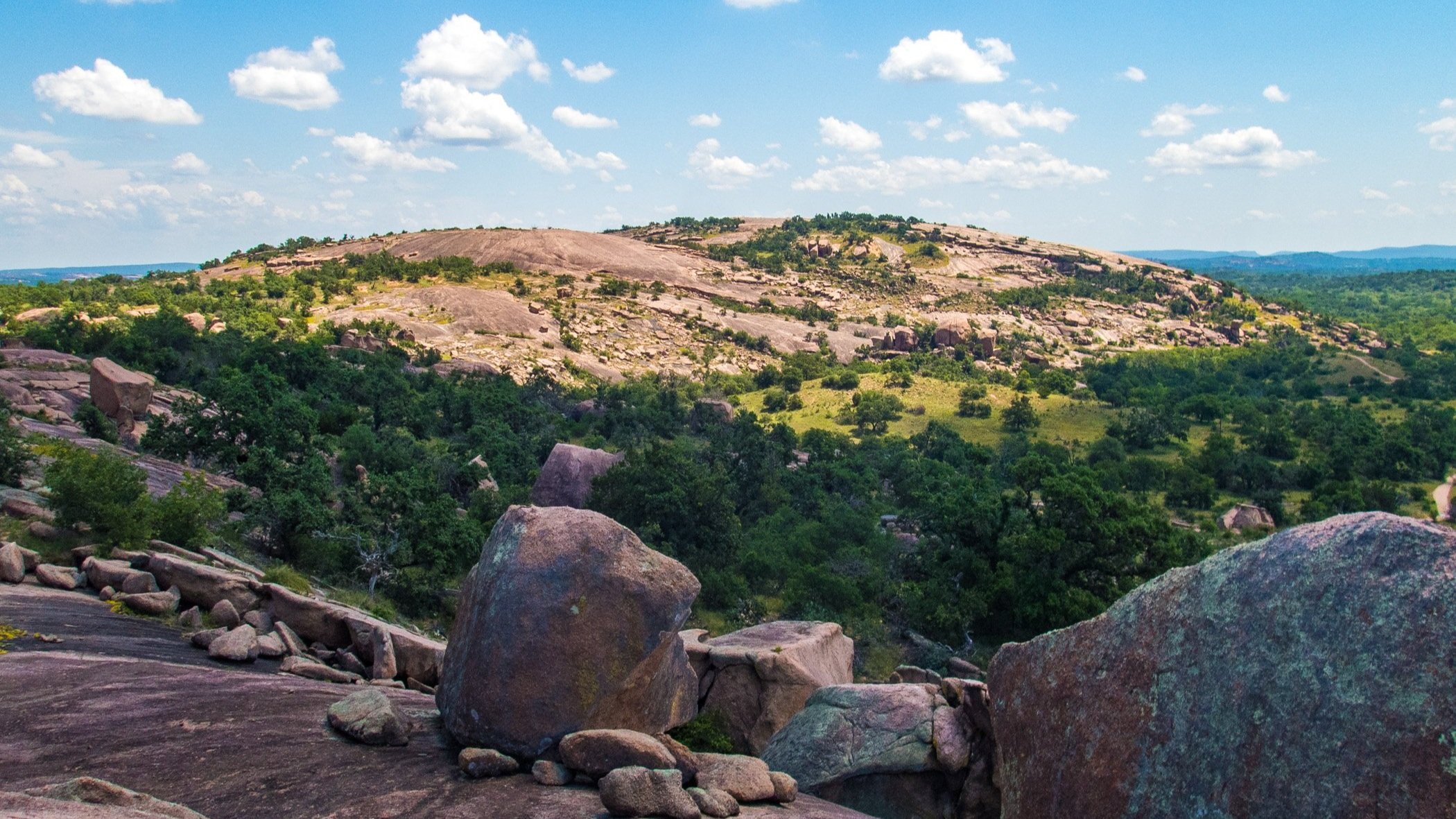A State Park System for Texas: 100 Years of Public Conservation
The view of Enchanted Rock State Park from TLC protected property. // Stephen Ramirez
There are many ways we protect land in Texas, but building connectivity of open space is an important task to see all of the benefits of conservation. In celebration of its centennial, we wanted to share the history of the state park system and the path to conservation in Texas.
About the author: Neel Baumgardner has been on the TLC board since 2016. He received a Ph.D. in environmental history and teaches in the Department of History at the University of Texas at San Antonio. His research focuses on public and private conservation efforts, including the state and national parks of Texas. Neel is finishing his first manuscript for publication that explores the creation of international parks along our nation’s shared borders with Canada and Mexico.
In May 1922, the Second National Conference on State Parks, sponsored by the National Park Service, was held at Palisades Interstate Park between New York and New Jersey, and three Texans were listed as attendees. The minutes include a brief statement from one of them.
“I feel that I cannot let this conference close without a word from Texas. I want to say that I travelled four days to come to this conference with no other objective but to hear and observe what these wonderful achievements have accomplished in the way of parks and playgrounds. I am sure that you all feel that Texas is asleep, but she isn’t; she is very much awake, and I am going back full of ideas, which I hope someday to put into action,” noted Mrs. James Welder.
The attendees from Texas, all women, included Welder from Victoria and two representatives from the Texas Federation of Women’s and Garden Clubs. Mrs. Welder did go back full of ideas and went on to serve on the first State Parks Board the next year. The appendix of the proceedings enumerated five state parks for Texas, all historical sites associated with the Texas Revolution, including Washington on the Brazos, Goliad, San Jacinto, Gonzalez, and King’s Park. Aside from these handful of historical sites, almost no lands had been dedicated as public parks. In fact, Texas had very little left of its public domain by 1922.
Texas entered into the union in 1845, and with the Compromise of 1850, state officials agreed to cede territory in what’s now several western states in exchange for monetary compensation and the retention of the balance of the state’s public domain. Over time, the Texas Legislature distributed this vast expanse of public land for settlement, railroad expansion, and the endowment of public education.
Parks Board Trip 1924 (Neff Collection, Texas Collection, Baylor University)
On May 1, 1923 during the Second Called Session of the Legislature, Margaret Tindale, an assistant secretary to the Governor, appeared before the House and read a message. In it, Governor Pat Neff called for the creation of a Parks Board and a statewide system of parks. The first State Parks Board consisted of David Colp as chairman, Mrs. W. C. Martin of Dallas as Vice Chair, Hobart Key of Marshall, Mrs. Phebe Warner of Claude, and Mrs. James Welder of Victoria. As the Texas Legislature provided absolutely no funds for acquisition, to secure parks, the State Parks Board and Governor Neff put together four multi-week regional explorations of the state to visit communities and make the case for donations. Members of the Board provided blank deeds for prospective donors at each of their stops.
“But if men are to grow stronger and more useful they must travel together in the early morn, walk 'neath the noon day sun and commune together in the cool of the eventide…Here together the rich and the poor, the young and the old, the sick and the well, the playful and the tired mix and mingle together in an exchange of thoughts, of aim and aspiration,” intoned Neff in one of many speeches as he crisscrossed Texas soliciting parks.
On January 14, 1925, just six days before leaving office, an assistant to Neff presented a message to be read before the Texas House. Neff reported fifty-two park sites had been offered. As remarkable as the number sounded, it took the Legislature until its 1927 session to accept the first slate of parks, and no systemic development occurred until 1933 with the Great Depression and make-work programs like the Civilian Conservation Corps.
Texas is a vast state comprised of 172 million acres. Land trusts, including TLC, conserve 1.8 million acres of the state in conservation easements – equal to our state parks (640,000 acres) and national parks (1.2 million acres) combined. With those numbers and an ever growing population, there’s quite a bit of work left to be done to conserve watersheds and open spaces.
As you enjoy your time in public lands, don’t forget to look over the fence beyond to the 95% of the state owned by our friends and neighbors. Conserving these private parcels are important to our future. Whether you are a landowner who would like to ensure the future protection of your property or a person who gets recharged by spending time with family and friends in the outdoors, we all have a role to play as stewards of our natural resources.
Celebrate 100 years by visiting one of our favorite state parks!
TLC board and staff have put together a list of just a few of their favorite hikes and swimming holes across the state to share with you. With TLC events slowing down to avoid the summer heat, we want to make sure you still have lots of ideas for getting out into nature.




